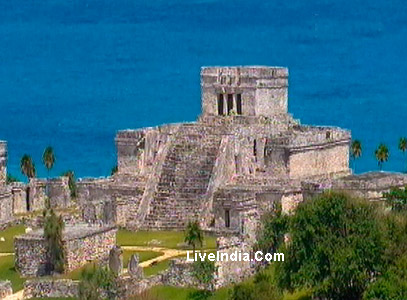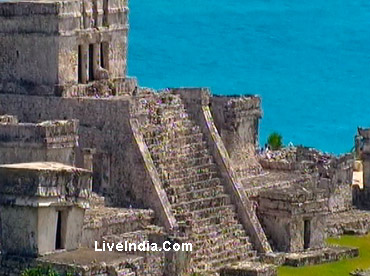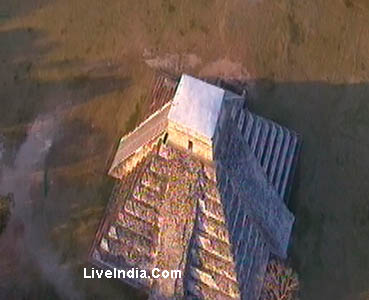|
The Mayan civilization
arose in Mesoamerica around 250 AD, influenced by the culture and religion
of the Olmecs. The Mayan urban culture especially flourished until about
900 AD, but continued to thrive in various places until the Spanish conquest.
 |
During this first 650
years, which scholars call the Classic Period, the Mayan civilization consisted
of more than 40 sizeable cities spread across modern-day Mexico, Guatemala,
and northern Belize.
At its peak, the total
population may have reached 2 million people, the majority of whom lived
in modern-day Guatemala. The cities seem to have been mainly ceremonial
centers, with the majority of the Maya living a rural, agricultural life
around the cities.
Sometime after 900 AD,
the Mayan culture declined dramatically and most of the cities were abandoned.
Latest scholarship attributes this decline to the loss of trade routes
due to war.
The great southern cities
became depopulated, but the cities of the Yucatan peninsula in Mexico (such
as Chichén Itzá, Uxmal, and Mayapán) continued to
thrive in the early part of the "Post-Classic Period" (900–1519). By the
arrival of the Spanish in the early 16th century, however, most of the
Maya were village-dwelling farmers. |
The remaining Maya were conquered
by the Spanish and converted (at least nominally) to Roman Catholicism.
The present-day Mayan peoples are spread mainly across southern Mexico,
with small numbers in Guatemala and Belize. They practice a religion that
combines Roman Catholicism with Mayan cosmology, deities, and domestic
rituals.
The Maya had a highly
sophisticated culture, and this included a written hieroglyphic language.
Mayan hieroglyphics were carved into stone monuments or pieces of bone,
painted on pottery, and written on books (codices) of bark paper.
| Mayan texts describe
religious rituals, astronomy, and divination, and are the most valuable
source of information on the ancient civilization.
Many of them were destroyed
by the Spanish because of their pagan religious content, but three main
codices have survived. Named for the cities in which they are now kept,
these are the Dresden, Madrid, and Paris codices.
The Dresden Codex contains
very precise tables of Venus and the moon and describes a method of predicting
solar eclipses Other important texts are those written by learned Indians
who transcribed or summarized Mayan hieroglyphic records into Latin script.
One of these is the Books of Chilam Balam, written in Yucatec Maya and
consisting of historical chronicles mixed with myth, divination, and prophecy.
Another text, The Ritual of the Bacabs, covers religious symbolism, medical
incantations, and similar matters. |
 |
Perhaps the most famous of
these texts is the Popol Vuh (1554-1558), which was written in Quiché,
a highland Maya language, and translated into Spanish by a priest. This
tells of the mythology and cosmology of the Postclassic Guatemalan Maya,
and shows central Mexican influences. It chronicles the creation of man,
the actions of the gods, the origin and history of the Quiché people,
and the chronology of their kings down to 1550.
These Mayan texts were
not regarded as sacred or authoritative in themselves (they are not revelations
from the divine like the Bible or Quran), but rather as important records
of religious rituals and knowledge.
 |
The Maya worshipped a
pantheon of nature gods, each of which had both a benevolent side and a
malevolent side. The most important deity was the supreme god Itzamná,
the creator god, the god of the fire and god of the hearth.
Another important Mayan
god was Kukulcán, the Feathered Serpent, who appears on many temples
and was later adopted by the Toltecs and Aztecs as Quetzalcoatl. Also important
was Chac, a hooked-nose god of rain and lightning.
A third god that frequently
appears in Mayan art is Bolon Tzacab, who is depicted with a branching
nose and is often held like a sceptre in rulers' hands. He is thought to
have functioned as a god of royal descent.
Mayan rulers were seen
as intermediaries between the gods and the people, and as semi-divine themselves.
They were buried in elaborate tombs filled with valuable offerings. |
The Mayan view of the afterlife
consisted primarily of a dangerous voyage of the soul through the underworld,
which was populated by sinister gods and represented by the jaguar, symbol
of night. The majority of Maya, including the rulers, went to this underworld.
Heaven was reserved for those who had been sacrificed or died in childbirth.
To the Maya, science and
religion were one and the same. The Maya developed an impressive system
of mathematics and astronomy, which was initimately related to religious
rituals. Their mathematical achievements included positional notation and
the use of zero; in astronomy, they accurately calculated a solar year,
compiled precise tables of positions for the Moon and Venus, and were able
to predict solar eclipses.
The Maya were obsessed
with time; to understand and predict various cycles of time allowed them
to adapt to and best make use of their natural world. Mayan cosmology had
it that the world had been created five times and destroyed four times.
On a more temporal scale, the various days of the year were considered
appropriate to specific activities, while some were entirely unlucky. |







